All about the mantras of Tara
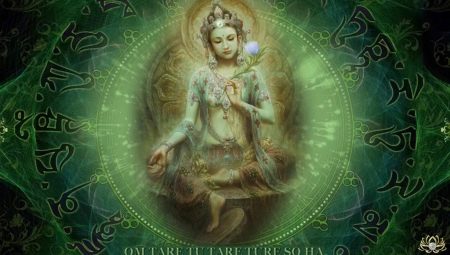
Tara is a symbol of universal compassion, patronizing all that exists. She is revered as the mother of all Buddhas and most quickly comes to the aid of those who are in a desperate life situation. The suffering ones always turn to the goddess Tara, and she willingly responds to them. Even her body position in the image symbolizes a willingness to immediately come and support the one who calls out to her.
Peculiarities
The Tara mantra is the most powerful of the protective mantras. Divine Tara, from which people ask for the gift of love and blessing, exists in White and Green incarnations. Turning to White promises longevity, while Green is asked for salvation and protection.
This deity saves a person from painful rebirths in future lives.
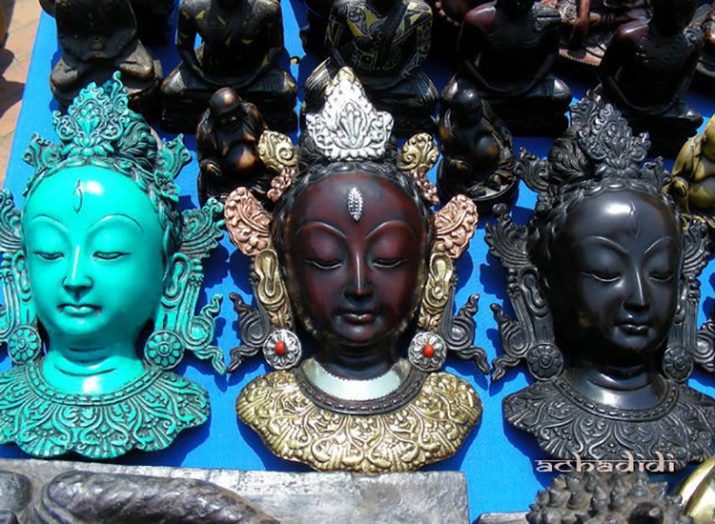
It is believed that 21 more essences of the goddess emerge from Tara, each of which is usually read a separate appeal. There is also a general appeal directed to twenty-one Tara. Images with the image of Tara are used as powerful amulets; many artists enthusiastically and with inspiration embody them on canvases. It is believed that such art promotes enlightenment.
Tara is pictured sitting on a beautiful white lotus flower, dressed in silk. The clothes of the mother of all Buddhas are inlaid with precious stones. Her body is translucent, devoid of density and filled with light. Tara's right leg is down, and her left is bent at the knee. She put her right hand on her right knee, and leaned her left palm against the region of the heart, squeezing a blue lotus in it (Utpala).
White Tara is distinguished by the presence of seven eyes - in addition to ordinary eyes, the goddess has these organs on her palms, feet and forehead. The color of the iris of the eyes depends on which Tara is depicted.In Green they are identical, in White they are colorless. Infinite compassion is reflected in the eyes.
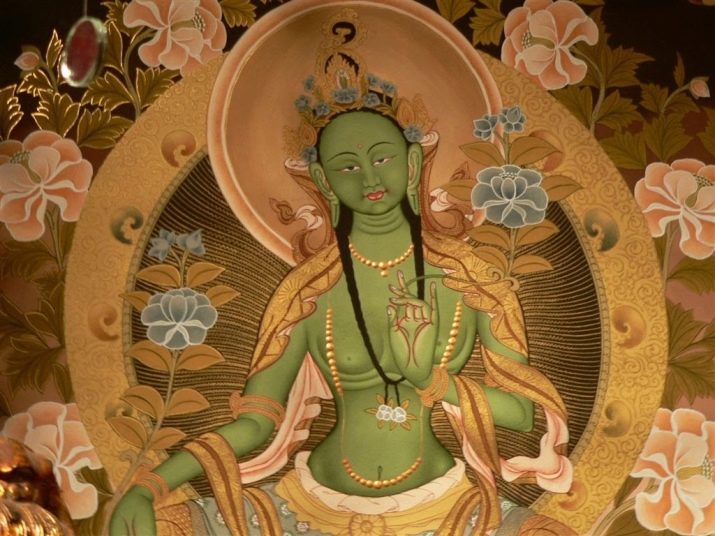
Types of appeals
Three types of appeals to the mother of all Buddhas are most often practiced: the mantra to Green, White and twenty-one Tara. In addition to the canonical types of Tara, there are also its recognized hypostases, for each of which there is its own text of the mantra. They all begin with the words: OM TARE TUTARE TURE ... the continuation depends on each specific visualized divine entity.

Black Tara
It represents a kind of "sacred anger" that allows you not to disdain by forceful methods to achieve your own good goals, if other methods do not work. Like many Tibetan deities who personify the wrathful side of power, this Tara is depicted with tiger fangs, symbolizing ferocity and an irrepressible appetite that consumes the demons of the mind. It is surrounded by a fiery halo, symbolizing the transformation of the entity through fire, which is considered an aspect of the active use of power and a symbol of the awakened Kundalini.
In parallel, in a good aspect, Black Tara is perceived as the Impeccable Keeper of the void, the Divine mother of compassion, preventing evil in any form.
The goddess is a little angry, but in her power to neutralize all the harm of black magic and conspiracies.
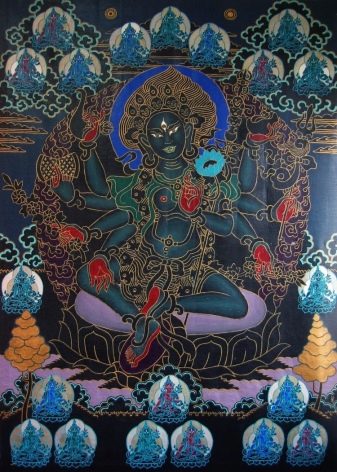

In Buddhism, the Black essence of Tara is its manifestation in anger, energetically similar to the Hindu goddess Kali. Angry Tara's head is also covered with grinning skulls. She is as black as Kali, three-eyed, ruling in three worlds. In fact, she is the embodiment of several aspects parallel to those of Shakti.
One of her incarnations is Simhamukha - Dakini with a lion's head and dark blue body color. The one who practices it owns the magic of preventing war, illness, poverty, hunger. It destroys evil and removes obstacles to the development of spirituality.
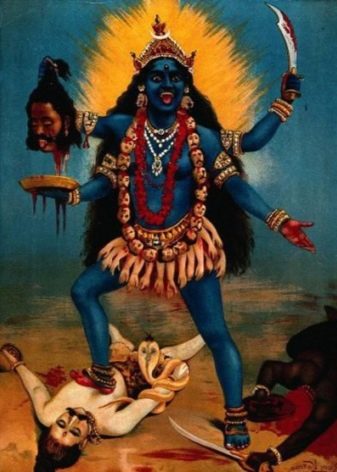
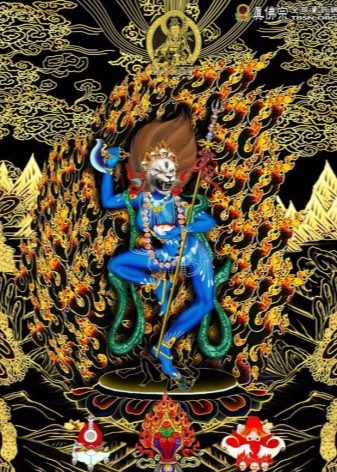
Red Tara
Many are familiar with the situation when, as a result of constant practices and techniques aimed at obtaining wealth, a zero total is obtained. The problem is quite simple to explain by the fact that attracting wealth on the subtle plane is not enough to materialize the already accumulated wealth on the physical level. The fiery-red hypostasis of Tara is designed to help you get what you want in the worldly view of this concept.
With the help of the mantra Kurukulla (the so-called Red Tara), you can get the coveted benefits.
The rules for reading mantras are standard for Eastern traditions: while reading the text, visualize your own well-being, mentally “bathing” in gold, jewelry and money.
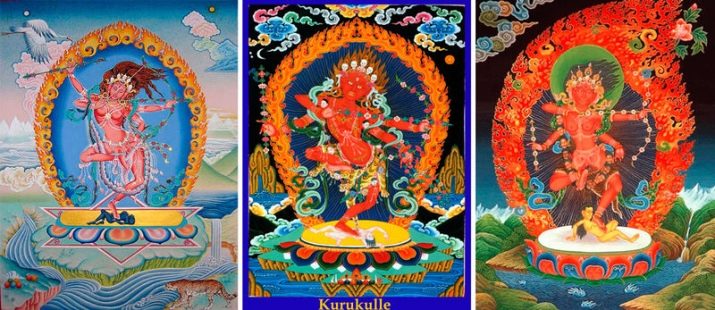
White-Ozontichnaya Tara
The goddess Dukkar was of particular importance in Eastern Tibet. According to legend, her mantra was never uttered, but emitted by vibrations coming from Ushnisha Buddha - the elevation on his head. Dukkar emerged from space itself. She is distinguished by great power, which is symbolized by the image of a goddess with a weapon in a thousand hands. This Tara has a thousand heads in five colors and a dozen lower and upper teeth - a symbol of an equal number of Protectors and Protectors. Her thousands of feet tread on all obstacles.
Reading the mantra of White-Osed Tara is the path to longevity, victory over all threats to life, as well as the ability to protect your property. One of the ancient texts speaks of this hypostasis of Tara in the context of Yeshe Korlo - the Wheel of Desire Fulfillment. It is visualized by many practitioners in an effort to feel in the place of a deity and to cope with all obstacles at once.
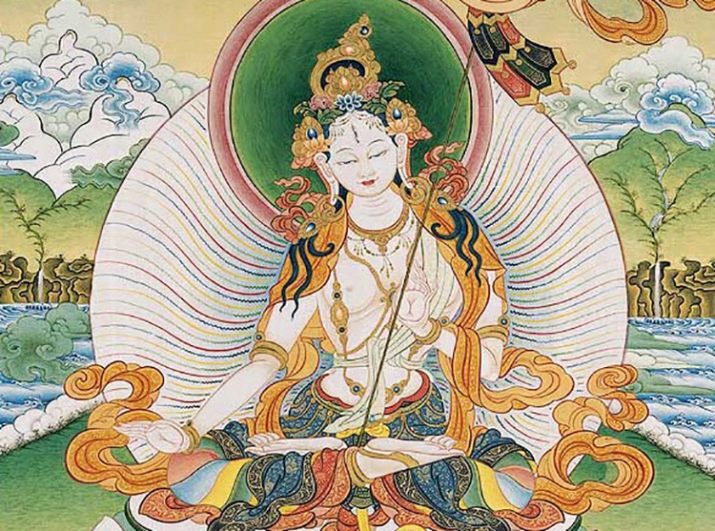
Yellow Tara
Bodhisattva Vasundhara is known as Tara - "Keeper of Treasures", "Stream of Gems" in Sanskrit, and in the Tibetan interpretation she is Dolma Sermo, "Yellow Liberator", the goddess of spiritual and material wealth, wisdom, fullness. The goddess Vasundhara is the wife of Kubera, the god of wealth. She is often depicted with him or next to the goddess Lakshmi.They ask for life in pleasure from Tara Serdog Chen - the Lady of Golden-yellow color, who is depicted with a yellow vessel in her hands.
Vasundhara is a bodhisattva, a liberating goddess who bestows piously acquired wealth. She also makes sure that spiritual wisdom is accompanied by good circumstances in the form of a high standard of living, success, longevity and happiness. Tara's skin color in the incarnation of Vasundhara is golden-bronze, in tune with precious metals, as a sign of nobility and generosity. The goddess has three faces: the right one is brown, the left one is of a reddish hue, and in the center is yellow.
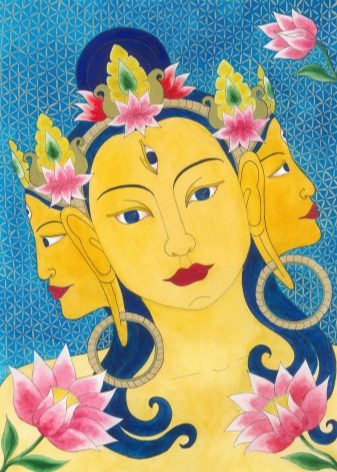
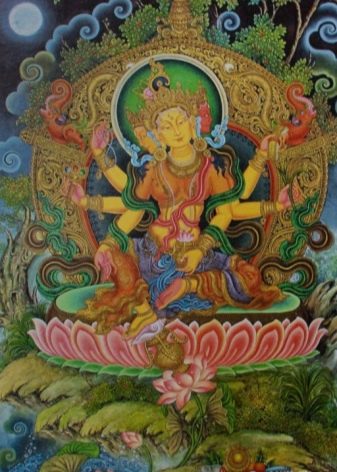
Vasundhara is usually depicted sitting on a lotus flower in the lalita asana position. Her right leg gracefully touches the filled jar of jewels. Less often, the yellow-skinned goddess is depicted not sitting, but standing. This Tara has from two to six hands - a symbol of multifaceted possibilities and an enlightened state. The lower left palm supports the vessel containing the treasures - a direct symbol of material well-being. One of the hands squeezes ears of corn - a symbol of abundance and fertility, also in his hands Tara holds the “Book of Transcendental Wisdom”, three precious stones, a rosary - a symbol of continuous practice. Her lower right hand is depicted in the warada mudra, as the personification of the "bestowing of divine blessings", sincerity, compassion and charity. The upper hand is depicted in the mudra of respect, greeting the Enlightened beings.
According to the Tibetan legend, the layman Sukandra asked Buddha Shakyamuni about the method of bestowing untold wealth in order to help others. So Sukandra received the Vasundhara mantra with holy texts from the Buddha. It helps develop natural generosity.

Orange Tara
Tara, also known as Marichi, bestows magical achievements and dispels the suffering of poverty. The orange goddess has several recognized guises.
- HUNG DRADROGMA - Proclaiming the Sound of HUM. The body of this Tara is red-yellow in color, and in her hands is a red vessel.
- PONGPA SELMA - Eradicating Poverty. The image of the goddess is distinguished by the fact that her body is orange-red, and a yellow vessel is placed in her hands.
- DROLMA ZHIGTEN SUMYOVA - Shivering the Three Spheres. A container with a skin of a red-yellow hue, with a yellow vessel in his hands. She pacifies the demons of Mara, eliminates infectious diseases. The goddess of incredible beauty makes everything auspicious.
By practicing the orange Marichi mantra, you can quickly restore lost strength, replenish vital energy. Practice brings back optimism and cheerfulness.
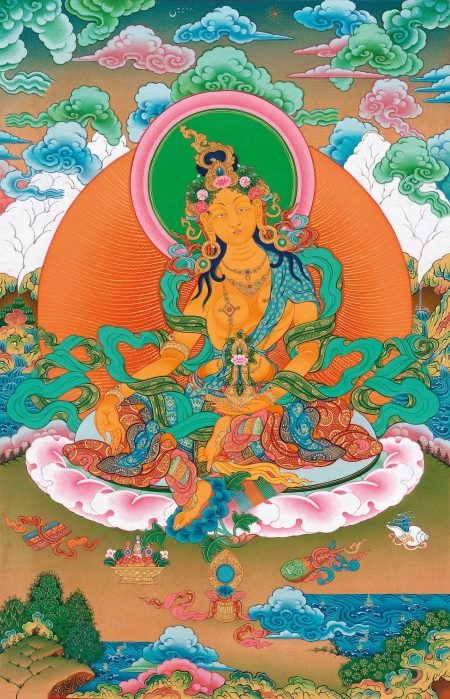
21 Tara
If you need to change your own life, you need to read the words of praise addressed to 21 Tara. To change for the better, at least once a day, sincerely and with a good message, you need to pronounce the mantras of each of the 21 incarnations of Tara.repeating them until there are obvious improvements in fate. You can also choose a certain mantra among a large cycle and practice until the situation is resolved in interesting and important areas of life.
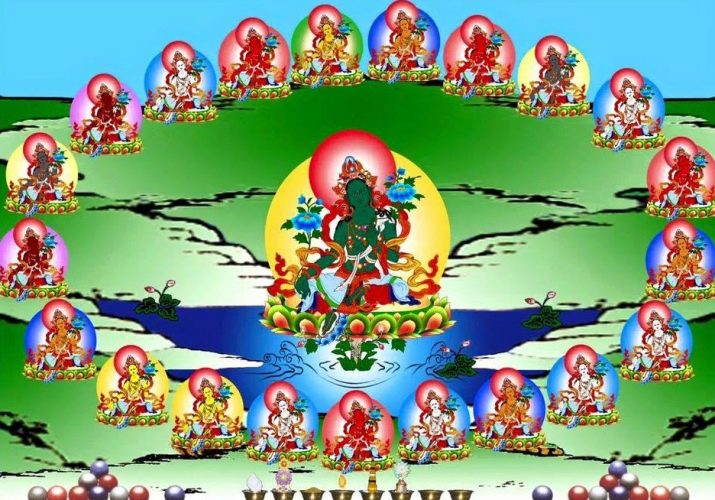
How many times and how to read it correctly?
For more effective practice, it is advisable to acquire a small statuette of Tara and look at the deity for a while before the chanting of the mantra. Only a few minutes later, take a pose identical to Tara, mentally transfer to the emerald space, presenting the goddess in front of you, and turn to her. The chant should be 15-20 minutes long.
The mantra is repeated several times. It is advisable to first learn the words addressed to the deity in order to pronounce them by heart. But this point is not obligatory, because it is believed that even those who do not remember the text literally receive help and support from the Goddess. The main and important condition is sincerity when performing the practice.
Conducting the ritual every day, enlightenment will come faster, and with it will come good luck and fulfillment of cherished desires. Mantra Tare relieves adversity and removes fears in a person's current life.

Recommendations
Tara is considered a symbol of Universal wisdom. According to the Buddhist faith, the goddess took a vow to help living beings until Samsara is completely empty. Call to the goddess with gratitude, recite mantras to avoid many adversities in your life. Before asking for help from the deity, it is advisable to conduct an offering ritual. Although the Divine Mother, helping everyone, will respond and gratuitously. It is important to combine mantras with mudras. The pronunciation is preceded by a visualization of the goddess to be addressed.
This is the only way the practice is considered to be done correctly and will bring the expected result.









